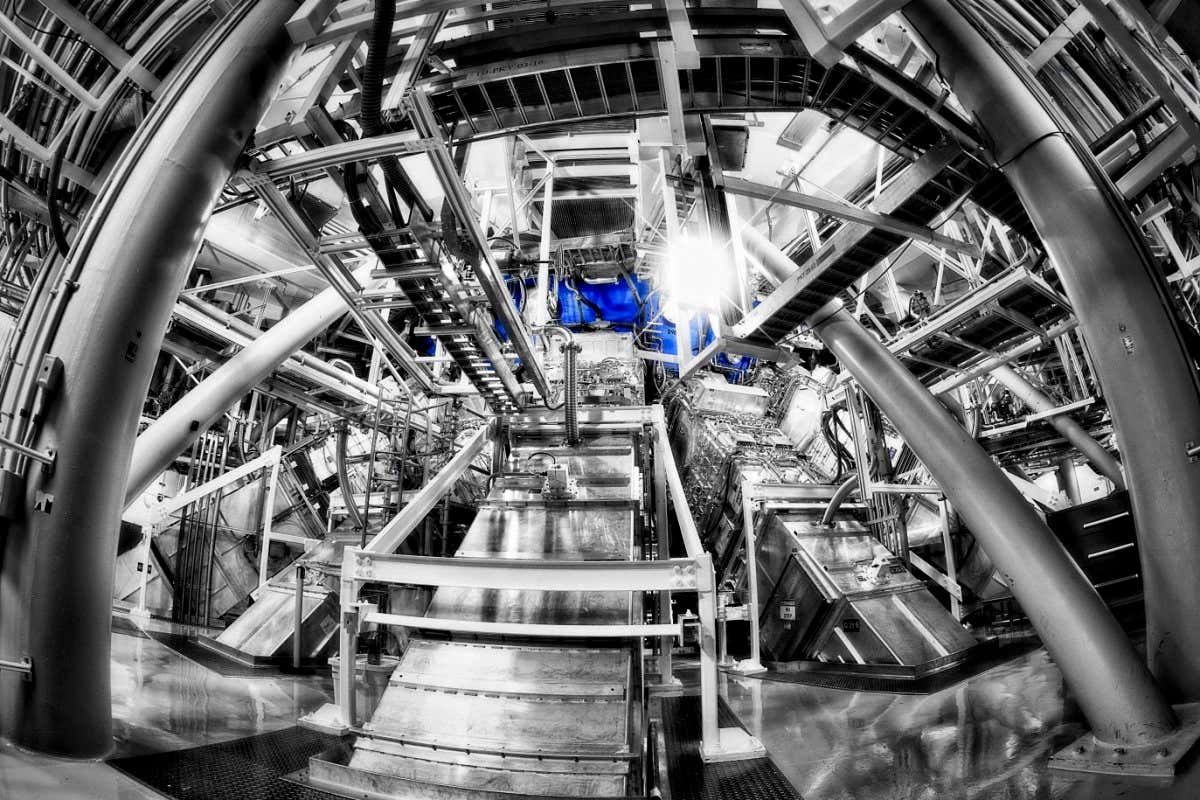[ad_1]
The National Ignition Facility in California Damien Jemison
For the first time on Earth, a controlled fusion reaction has generated more power than it requires to run, researchers have confirmed. The experiment is a major step towards commercial fusion power, but experts say there is still a vast engineering effort needed to increase efficiency and reduce cost.
Rumours of the experiment at Lawrence Livermore National Laboratory (LLNL) in California emerged on 11 December, but the news has been formally announced in a press conference today. In an experiment on 5 December, the lab’s National Ignition Facility (NIF) fusion reactor generated a power output of 3.15 megajoules from a laser power output of 2.05 megajoules – a gain of around 150 per cent. However, this is far outweighed by the roughly 300 megajoules drawn from the electrical grid to power the lasers in the first place.
There are two main research approaches aiming to achieve viable nuclear fusion. One uses magnetic fields to contain a plasma, while the other uses lasers. NIF uses the second approach, known as inertial confinement fusion (ICF), where a tiny capsule containing hydrogen fuel is blasted with lasers, causing it to heat up and rapidly expand.
This creates an equal and opposite reaction inwards, compressing the fuel. The nuclei of hydrogen atoms then fuse together to form heavier elements and some of their mass is released as energy – just as it is in the sun.
Until now, all fusion experiments have required more energy input than they generate. NIF’s previous record, confirmed in August this year, produced an output that was equivalent to 72 per cent of the energy input from its lasers. Today’s announcement confirms that researchers have not only reached the crucial break-even milestone, but surpassed it – albeit if you ignore the energy required to power the lasers. During the press conference, Jean-Michel Di-Nicola at LLNL said that at peak power – which NIF only achieves for a few billionths of a second – the lasers draw 500 trillion watts, which is more power than output by the entire US national grid.
The White House Office of Science and Technology’s policy director Arati Prabhakar said reaching the milestone was a “tremendous example of what perseverance can achieve” and that the results brings viable fusion power one step closer.
“It took not just one generation, but generations of people pursuing this goal. This duality of advancing the research, building the complex engineering systems, both sides learning from each other – this is how we do really big hard things, so this is just a beautiful example,” she said.
Jeremy Chittenden at Imperial College London says the experiment is a historic moment for fusion research. “It’s the milestone that everyone in the fusion community has been striving to achieve for 70 years now,” says Chittenden. “It’s a major vindication of the approach that we’ve been trying, for ICF, for nigh on 50 years. It’s very significant.”
Most fusion investment is currently poured into the alternative approach of magnetic confinement, in particular a reactor design called a tokamak. The Joint European Torus (JET) reactor near Oxford, UK, began operating in 1983. When running, it is the hottest point in the solar system, reaching 150 million°C (270 million°F). Earlier this year, JET sustained a reaction for 5 seconds, producing a record 59 megajoules of heat energy.
A larger and more modern replacement, the International Thermonuclear Experimental Reactor (ITER) in France, is nearing completion and its first experiments are due to start in 2025. Another reactor using the same design, the Korea Superconducting Tokamak Advanced Research (KSTAR) device, recently managed to sustain a reaction for 30 seconds at temperatures in excess of 100 million°C.
LLNL director Kim Budil said at the press conference that the delay between the experiment and the announcement was because a team of third-party experts was brought in to peer-review the data. She said that now it has been confirmed, it is likely that a laser-based power plant could be constructed within a “few decades”, but that the technology for tokamak reactors was more mature.
“There are very significant hurdles, not just in the science, but in technology,” she said. “This is one igniting capsule, one time, and to realise commercial fusion energy, you have to do many things; you have to be able to produce many, many fusion ignitions per minute, and you have to have a robust system of [laser] drivers to enable that.”
Currently, NIF can be run for an extremely short period, then it has to spend several hours cooling its components before it can be turned on once more. Approaches being tried by new commercial start-ups may prove a better way forward, says Chittenden.
“If we stick at trying to do this through massive scale projects, which take billions of dollars to construct and tens of years to develop, it could well be that fusion arises too late to have an impact on climate change,” says Chittenden. “What I believe we really need to do is to concentrate upon increasing the diversity of approaches so that we can try to find something that has a lower impact cost and a faster turnaround, so that we might be able to get something in 10 or 15 years’ time.”
In addition to providing invaluable data for engineers working on practical reactor designs, Chittenden says NIF’s results could lead to other advances in physics, as the reactions seem even more intense and rapid than those in our sun, and more like those happening in a supernova. “We’re at extremes of pressures, densities and temperatures that we’ve never been able to access in the laboratory before,” he says. “These are processes that allow us to study what’s happening in the most extreme states of matter in the universe.”
Gianluca Sarri at Queen’s University Belfast says the findings will allow all those fusion researchers to press on, safe in the knowledge that extracting energy from fusion is possible.
“Now it’s just, and I say ‘just’ in inverted commas, a matter of refining and technical adjustments. It’s not going to happen tomorrow, obviously, because there are technical issues. We’re still far from a reactor. But we are on the right road,” he says. “In terms of clean energy, this [fusion research] is definitely the most ambitious route, but eventually will be the most rewarding because the amount of energy that you can unlock is potentially limitless.”
Sarri says that his intuition is that the first working reactors will be tokamak devices, but that ICF research still has a vital role to play. “Both routes should go ahead, because they inform each other. There’s a lot of exchange of information between the two schemes,” he says. “The way they work is, in concept, similar.”
More on these topics:
[ad_2]
Source link




